Technology Stack
HAProxy
“HAProxy is a free, very fast and reliable solution offering high availability, load balancing, and proxying for TCP and HTTP-based applications. It is particularly suited for very high traffic web sites and powers quite a number of the world’s most visited ones. Over the years it has become the de-facto standard opensource load balancer, is now shipped with most mainstream Linux distributions, and is often deployed by default in cloud platforms. Since it does not advertise itself, we only know it’s used when the admins report it :-)”
Reference: http://www.haproxy.org/
We’ll be using HAProxy to create a Load Balancer (LB) — as we’ve mentioned here — for the Kubernetes API.
Let’s imagine a scenario: What would happen if we had only one HAProxy instance performing the Load Balancing? We would introduce a Single Point of Failure (SPOF) to our architecture. I mean, if, for any reason, this single HAProxy failed, we would totally lose access to the Kubernetes API. Of course, this is a situation we want to avoid at all costs, given the importance of this component to our solution.
To solve this problem, HAProxy will be part of a High Availability Cluster (HA) powered by a Floating IP and with at least two HAProxy services configured, as already presented here.
In summary, we will be creating a Highly Available Cluster for Load Balancing.
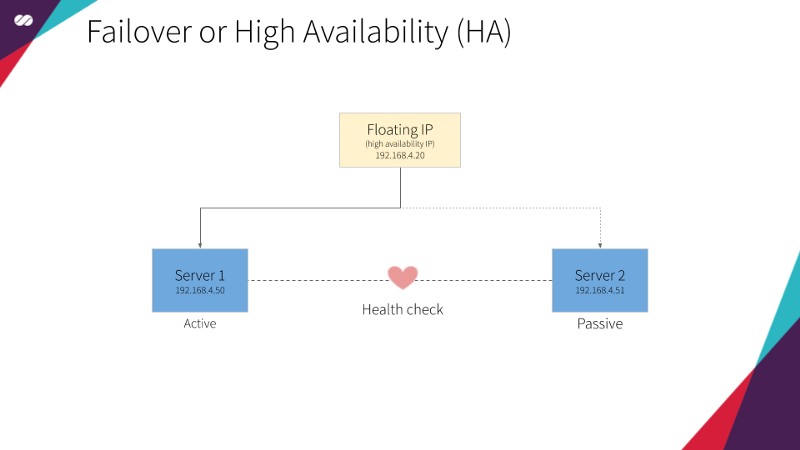
Corosync
“The Corosync Cluster Engine is a Group Communication System with additional features for implementing high availability within applications. Corosync is used as a High Availability framework by projects such as Apache Qpid and Pacemaker.”
Reference: https://clusterlabs.org/corosync.html
Corosync has two main purposes: Keeping the status of the cluster (knowing when a node joins or leaves the cluster) and distributing messages to all the cluster members.
Keeping the status of the cluster
A node joins the cluster
To update the cluster status, all nodes of the cluster should have Corosync installed and configured the same way. Thus, every time a node containing Corosync starts, imagine the following conversation takes place:
- The new node sends a broadcast message saying: “Is there any Corosync member there?”
- The existing Corosync instances in the network receive the message and respond: “I’m here!”
- The new node receives the response from these existing instances and says: “Hi there! I want to join the cluster. Here are my credentials!”
- The existing Corosync instances receive this request-to-join message, evaluate the credentials (configuration) received and decide, based on the quorum configuration, if the new instance should or shouldn’t be accepted to this “very special club”.
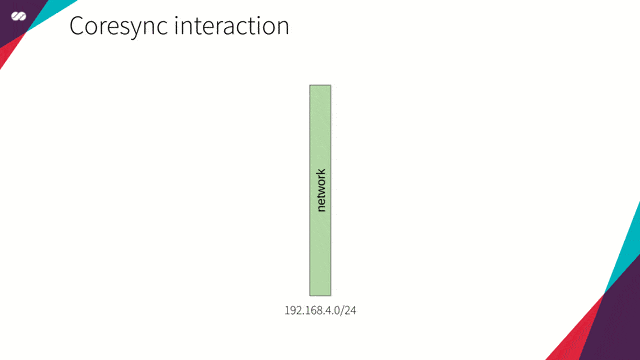
A node leaves the cluster
After a node joins this “very special club”, it gets to know all the other nodes. On the same way, all the other nodes get to know the new node, as well as they already know all the previous members.
To know when a node leaves the cluster, Corosync continuously monitors the health of the node members. For this, imagine the following scenario:
- Each node has a list containing the addresses of all the other nodes;
- Each node will interact with the nodes in its local list;
- If for, any reason, the node is not able to interact with a given node from this local list, then it will consider that node as unhealthy;
- The node will then consult all the other members to check how they see this potentially unhealthy node.
- Each node will have a vote saying whether that node is healthy or unhealthy from their point of view.
- Corosync will then evaluate the quorum configuration against the received votes to decide whether the node should be marked as healthy or unhealthy.
- If the node is marked unhealthy it will still be known to the cluster but won’t be used while it is in that state.
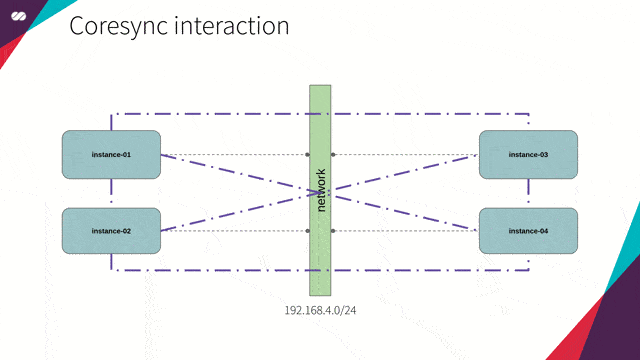
Pacemaker
“Pacemaker is an Open Source, High Availability resource manager suitable for both small and large clusters.”
Reference: https://clusterlabs.org/pacemaker/
The definitive open-source high-availability stack for the Linux platform builds upon the Pacemaker cluster resource manager.” — LINUX Journal
Pacemaker creates and configures resources in the cluster created and managed by Corosync.
The main purpose of Pacemaker here is to make our Loader Balancer Highly Available. To do so, we will use Pacemaker to declare a Floating IP and an HAProxy resource which will both be setup in the nodes managed by the Corosync cluster.
Pacemaker uses a declarative approach. It means we will create a configuration file specifying which resources should exist on each node and how these resources relate to each other. This relationship, in our case, is a mutual dependency between the Floating IP and the HAProxy resources. It means that they both depend on each other. The Floating IP should only be active in a given node if the HAProxy is active in the same node and vice-versa.
In simple terms, when a node is in active mode, we want the Floating IP and HAProxy to be assigned to and be executed on it, while all the other nodes will be in passive mode until, for any reason, the node or the resources attached to it fail. When that happens, the resources that are assigned to the active node are “migrated to” (or started on) one of the passive nodes where all the dependency conditions can be satisfied. Once this happens, the selected node becomes the active one and the previously active node transitions to the passive state. Check the animation below:
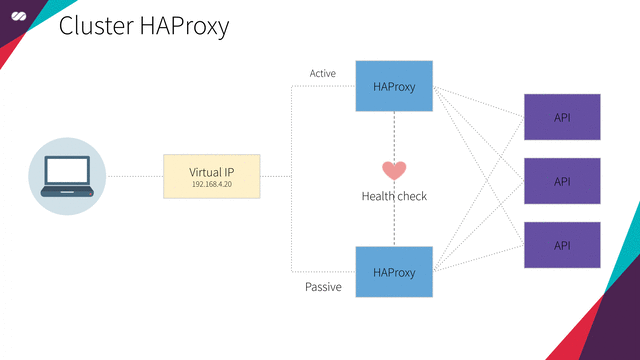
dnsmasq
“Dnsmasq provides network infrastructure for small networks: DNS, DHCP, router advertisement and network boot. It is designed to be lightweight and has a small footprint, suitable for resource-constrained routers and firewalls. It has also been widely used for tethering on smartphones and portable hotspots, and to support virtual networking in virtualization frameworks. Supported platforms include Linux (with glibc and uclibc), Android, *BSD, and Mac OS X. Dnsmasq is included in most Linux distributions and the ports systems of FreeBSD, OpenBSD and NetBSD. Dnsmasq provides full IPv6 support.”
Reference: http://thekelleys.org.uk/dnsmasq/doc.html
We will be using dnsmasq to provide the DNS and DHCP functionality for our hosts (nodes).
- DHCP will be responsible for the distribution of IP addresses and network configuration for each new host (node) that joins the network. This removes the need for creating too many settings for each new host that joins the network as well as the need to do this manually. The host performs a broadcast to the network, and the DHCP service responds with the settings needed. (check the animation below)
- DNS is responsible for resolving names inside our internal network as well as names from the public internet.
DHCP and DNS will work in synchronization; that is, for each new host that joins the network, DHCP updates the DNS service with the mapping of this hostname to its provided IP so we can refer to a new host by its name — not by its IP — without worrying about its IP address.
As a more practical example, consider what usually happens when we create a new instance on cloud platforms (GCP, AWS, Azure, etc). Each new instance created immediately receives an IP, DNS resolvers, routes and hostname registration in the internal DNS. At the end of the day, it’s DHCP, together with DNS, who is doing this work for us behind the scenes.

VirtualBox
“VirtualBox is a powerful x86 and AMD64/Intel64 virtualization product for enterprise as well as home use. Not only is VirtualBox an extremely feature rich, high-performance product for enterprise customers, it is also the only professional solution that is freely available as Open Source Software under the terms of the GNU General Public License (GPL) version 2.”
Reference: https://www.virtualbox.org/
Well, since we don’t have access to an actual bare-metal server, we’ll be using VirtualBox (an open source alternative) for simulating machines and networks in our data center.
This technology stack is all we need to exercise the concepts demonstrated throughout this series of articles.

cloud-init
“cloud-init is developed and released as free software under both the GPLv3 open source license and Apache License version 2.0. It was originally designed for the Ubuntu distribution of Linux in Amazon EC2, but is now supported on many Linux and UNIX distributions in every major cloud.”
Reference: https://cloud-init.io/
cloud-init is a utility for instance initialization. It allows for automatic configuration of instances when they are initialized, transforming a generic image of Linux into a configured server in a few seconds, quickly and easily.
The cloud-init utility that is available in the latest Linux distributions is capable of performing the setup of services, users and packages. One of the most popular formats for user-data scripts is the cloud-config file format.
cloud-config files are special scripts designed to be processed by the cloud-init utility. They are usually used to setup a server during its first boot.
We can see cloud-init in action below (tip: you can reduce the video velocity to see it in more detail):
LVM
“LVM means Logical Volume Manager.
What is the Logical Volume Management?
The Logical volume management provides a higher-level abstraction of the disk storage on a computer system than the traditional view of disks and partitions. This gives the system administrator much more flexibility in allocating storage to applications and users.
Storage volumes created under the control of the logical volume manager can be resized and moved around almost at will.”
Reference: http://tldp.org/HOWTO/LVM-HOWTO/
Imagine your company is to rent conference centers. The conferences hosted at these venues vary in size, ranging from huge events such as Google I/O and AWS re:Invent to smaller events like the Annual Whatever-Fancy-Convention-You-May-Imagine-Here.
To maximize the efficiency of use of these spaces, each venue is basically a huge hangar without any fixed divisions of its space. Having this configuration allows your company to divide the space into smaller slots, which may vary in size.
Imagine Google I/O, for example. During the conference, a bigger slot may be configured to host the keynote sessions and, right after these sessions end, the space may be reconfigured into smaller sections to hold the other sessions of the event.
That’s basically what LVM allows us to do with our disks. LVM allows us to configure our servers without having to know in advance what’s their intended use. We don’t need to know what services will run on them, neither what’s the expected volume of data these services will generate. It also allows us to manipulate and resize volumes in real time, just like in the example for venue space allocation in conferences above.
In our specific case, since we are going to create a VM image that will be the base for many other images (Gateway, HAProxy, Kubernetes master/worker nodes and Gluster), with each service having its own demand for space (our slots, in this case, would be /var, /usr, /tmp, /opt, / etc), LVM will provide us with the flexibility to resize our partition volumes as needed without having to worry about this details in advance.
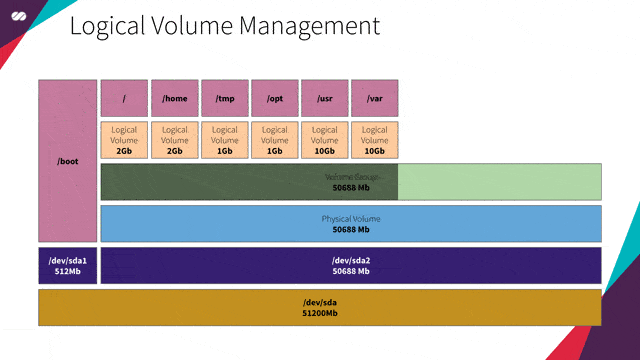
LVM extension concept in action
Gluster
“Gluster is a free and open source software scalable network filesystem.”
Reference: https://www.gluster.org/
You can see the objective of the Gluster here.
Docker
“Docker is a collection of interoperating software-as-a-service and platform-as-a-service offerings that employ operating-system-level virtualization to cultivate development and delivery of software inside standardized software packages called containers. The software that hosts the containers is called Docker Engine. It was first started in 2013 and is developed by Docker, Inc. The service has both free and premium tiers.”
Reference: https://en.wikipedia.org/wiki/Docker_(software)
Reference: https://www.docker.com/
Docker was initially developed based on LXC technology but has become independent. It offers more than just running containers: it makes it easy to create, build, upload, and control version images.
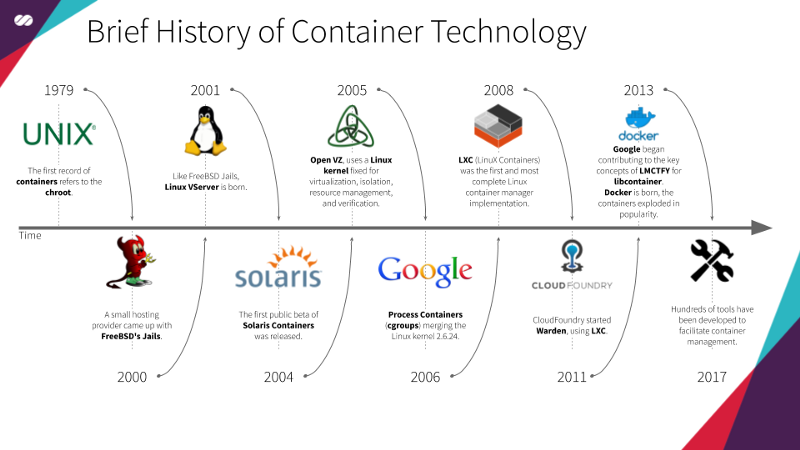
Above is a brief summary of the history of containers taken from Wikipedia and other sources
This is essentially a way of packing your software in container format. But what does that mean? It means that all your software and its dependencies (like libraries, configurations, etc) are contained in this container, making it easier to port your application without having to worry about potential differences in the environment where your application is deployed into.
One of the great advantages of this approach is that you can start your container in any other environment or new machines without having unexpected errors or additional configurations since everything your application needs is packaged inside the same container. In this way, the management of the container becomes: predictable, repeatable and immutable.
Some may argue the same could be achieved through virtualization. This assumption is correct and the result would be practically the same but the big difference here is that we have better use of our resources. Using containers, we are able to share our OS resources, removing the need for an entire operating system host our application. For a better understanding of this concept, check the image below:
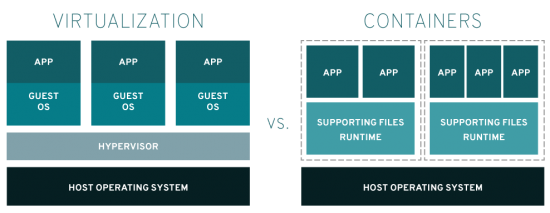
Image by: https://www.redhat.com
All this sounds really great but what happens when I have an ecosystem of applications running on Docker containers? This makes our management work very unproductive, boring and prone to errors. That’s where Kubernetes joins the party. Kubernetes is an open-source container orchestration system for automating application deployment, scaling, and management, able to manage containers smartly and cleanly.
Kubernetes
“Kubernetes (K8s) is an open-source system for automating deployment, scaling, and management of containerized applications.”
Reference: https://kubernetes.io/
As we saw above, Kubernetes is an open-source container orchestration system for automating application deployment, scaling, and management, able to manage containers smartly and cleanly.
We’ll cover the internals of Kubernetes in detail in the other topic.

Debian
“Debian is a free operating system (OS) for your computer. An operating system is the set of basic programs and utilities that make your computer run.”
Reference: https://www.debian.org/
Ubuntu
“Ubuntu is an open source software operating system that runs from the desktop, to the cloud, to all your internet connected things.”
Reference: https://www.ubuntu.com/
